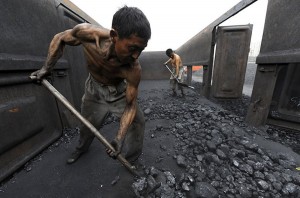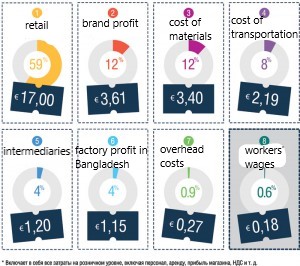 (This educational material has been prepared as part of the course “The Political Economy of Capitalism”)
(This educational material has been prepared as part of the course “The Political Economy of Capitalism”)
16. How surplus value is created.
So, the sale and purchase has been accomplished: the worker “voluntarily”, of their own free will, has sold their labor power, the capitalist has bought this commodity at the labour market in order to obtain surplus value in the process of consuming it.
The act of buying and selling labor creates a distorted view of the relationship between the two main classes of bourgeois society: the capitalists and the workers. On the market everything is done in accordance with the requirements of the law of value. The impression is created of complete equality between the capitalist as the owner of money and the worker as the owner of the commodity (labor power). Based on this, the bourgeoisie and its scholarly defenders try to prove that there is not and cannot be any contradiction between capitalists and workers.
However, the relationship between the commodity and the owner does not end at the market, but only begins there.
This is how Karl Marx describes their behavior after they have left the market: “The former owner of money marches ahead as a capitalist, the owner of labor follows him as his worker; one chuckles meaningfully and is eager to get down to business; the other walks dejectedly, huddled like a man who sold his own skin at the market and therefore sees no future perspective but one: that this skin will be hacked.
Why is the capitalist in a rush? Because once he has the labor force at his complete disposal, he is eager to extract surplus value as quickly and as much of it as possible.
How does it happen? To clarify the process of the creation of surplus value by workers, let’s take the following example.
A capitalist who owns a shoe factory, in order to increase their capital, buys raw materials and other kind of materials and, of course, hires workers, without whose labor the machines cannot move and the raw materials cannot be turned into a finished product. He sells the newly produced goods, and with the proceeds he buys raw materials and supplies again and pays for labor power.
Let us assume that: 1) each worker makes 10 pairs of shoes within 4 hours; 2) the consumption of raw materials, auxiliary materials, depreciation of machines, buildings, etc., for these 10 pairs of shoes is $30; 3) the daily cost of labor power is $8; 4) every hour of labour each worker creates a value equal to $2.
How much will the 10 pairs of shoes created by the worker over those 4 hours of labor cost?
First, this will include the cost of raw and other materials, as well as the depreciation of machines, tools, etc. – 30 dollars, and secondly, the new value created by the labor of the worker during 4 hours, which is $8; therefore, the cost of 10 pairs of shoes will be expressed in the sum of 38 dollars.
Now let us calculate what these 10 pairs of shoes cost the factory owner. The cost of production was $30, the daily cost of labor is $8. Total – $38, which is exactly how much the manufacturer received for the newly manufactured products.
Would the entrepreneur be satisfied with this result? Of course not. He didn’t buy the labor power and raw materials just to receive exactly what he spent. He seeks a surplus, a surplus to his expenditures.
How can the capitalist achieve an increase in value? There is only one way: to make the labor force he had bought work beyond four hours. After all, the value of raw materials and other means of production does not increase by itself; it is only transferred to the new product (shoes, in our example) by the laborer’s labor. The labor force is another matter. The capitalist bought it from the worker for $8, which equals the daily cost of using it. In other words, for $8 the laborer can fully recover the strength he needs to continue working. Under the terms of our example, this took 4 hours of labor time.
But the factory worker does not make the worker work 4 hours, but much more, let us suppose 8 hours. What would the result of production look like then?
An 8 hour work day will produce 20 pairs of shoes. What will the cost of the shoes be?
It will be equal to the $60 spent on costs (the means of production) plus the new value created by the labor of the worker in 8 hours, which is equal to $16. The total is $76.
Let’s calculate the entrepreneur’s expenses: $60 for the means of production and $8 for the daily cost of labor. The total is $68. Thus, after spending $68, the factory owner received $76.
The difference, $8, is the surplus value created by the labor of the worker. The laborer created a value of $16 during the 8 hours of labor, but only had to work 4 hours to reproduce the cost of his labor power. This means that for the remaining 4 hours he worked for the capitalist for free, receiving nothing in return.
В. Lenin cites the following factual data which clearly shows exactly who creates surplus value and who appropriates it. In 1908, capitalist industry in Tsarist Russia employed 2,253,787 workers. During that year the workers received 555.7 million rubles, i.e., an average of 246 rubles per person. The total amount of production was 4651 million rubles, and the total expenses of the capitalists were 4082 million rubles. So the industrialists pocketed 568.7 million rubles. Consequently, each worker in a year created a new value equal to 498 rubles. (246 + 252), but more than half of this value was gratuitously appropriated by the capitalists. Citing these calculations, Lenin notes: “Hence it follows that the worker works for himself the smaller half of the day, and the larger half of the day for the capitalist. If, for example, we take the average working day to be 11 hours, it appears that the worker is only paid for 5 and a half hours and even somewhat less than 5 and a half hours. For the other 5 and a half hours the worker works for nothing, receiving no pay, and the entire output of the worker during that half day period constitutes the profit of the capitalists.
But that’s the way it used to be, more than a hundred years ago. Now, thanks to the improved technology and highly productive machines at which the workers work, they no longer work for the capitalists half of their working time (on average), but 99% of it, if not more!
Here is the most obvious example – data from the International Trade Union Confederation’s report “Scandal: The Global Supply Chains of the 50 Largest Companies – An Insider’s Look”.

They show that the total expenses of the capitalist monopolies to produce and sell one T-shirt worth 29 euros do not exceed 6.04 euros, that workers receive only 0.18 euros, and the rest, 22.96 euros, is the profit of the capitalists! This means that the workers employed in the production of this T-shirt work for themselves only 1\156 of their working time, and 155\156 of the time they work for the multinational companies for free!!! That’s where their owners, the oligarchs, get their profits – the workers just gift them their labor! Slave owners and feudal kings of past centuries never even dreamed of such gifts.
We have discovered that the working day is divided into two parts. That part of the working day which is necessary in order to create value equal to the value of labor power is called necessary labor time, and the labor expended during that time is called necessary labor. The other part of the working day, when the worker creates surplus value, which is appropriated by the capitalist without compensation, is called surplus working time, and the labor expended during it is called surplus labor.
Therefore, surplus value is the value created in surplus time by the unpaid labor of the wage laborer. In “Das Kapital”, Marx expressed it with the Latin letter “m” deriving from the word “mehrvert” – super value.
The essence of capitalist exploitation is that the surplus value created by the labor of hired workers is appropriated by the capitalists. Surplus value serves as a source of income for all exploiting layers of bourgeois society: industrialists, merchants, bankers, landowners, etc.
The acquisition of surplus value is the driving motive, the goal of capitalist production. Capitalists buy labor in order to obtain surplus value. “…Capital,” Marx wrote, “has only one vital urge, the urge to increase, to create surplus value, to absorb with its permanent part, with its means of production, the largest possible mass of surplus labor. Capital is dead labor, which, like a vampire, comes alive only when it sucks in living labor and lives the fuller the more living labor it absorbs.
The law of surplus value expresses the basic productive relation of bourgeois society – the relation of the exploitation of wage laborers by the class of capitalists.
The production and appropriation of surplus value is the basic economic law of capitalism. “The production of surplus value or profit,” Marx pointed out, “is the absolute law of this mode of production.
The law of surplus value is the law of the emergence, existence, development and demise of the capitalist mode of production. Capitalism emerges only when conditions and possibilities of free hiring of labor force, conditions and possibilities of free appropriation of hired workers’ surplus labor are created, when money and means of production are transformed into means of extraction of surplus value. (The latter is very important for understanding the processes of the destruction of Soviet socialism and the restoration of the capitalist mode of production in its place.)
The law of surplus value, as the basic law of capitalism, leads to the growth of the productive forces of society, which finds expression in the construction of more and more new enterprises, in the improvement of production techniques and technology of production of goods, in the growth of labor productivity. But along with this, the law of surplus value creates the conditions for the inevitable demise of capitalism. The basic contradiction of capitalism deepens – the contradiction between the public character of production and the private capitalist form of appropriation. The growth of the productive forces leads to a gigantic communalization of production. And the wealth of society is accumulated more and more by a tiny bunch of the largest capitalists.The development of capitalist production, as we know, is the intensification of the exploitation of hired laborers, since the labor of the latter is the only source of surplus value. (It’s important to remember this when listening to the bourgeois government’s constant call for “development”. By the latter it means further intensification of the exploitation of the working class.) Therefore, the intensification of the contradiction between labor and capital leads to a sharp sharpening of the class struggle, to the growth of organization and cohesion of the working class. This prepares the conditions for the revolutionary transformation of capitalism and makes the victory of the socialist revolution inevitable. “The doctrine of surplus value,” Lenin pointed out, “is the cornerstone of Marx’s economic theory”.